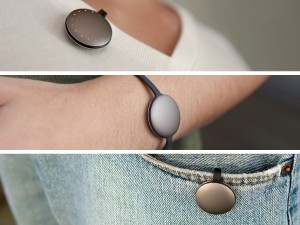
The Misfit Shine is an example of a partially passive wearable sensor.
The future of sensors won't be handheld devices like Star Trek's tricorder. It will be invisible sensors in your shoes, floorboards, and cars that quietly collect your health data, analyze it, and alert you, your doctor, or your loved ones only when something goes wrong. That's the prediction in "Making Sense of Sensors: How New Technologies Can Change Patient Care."
Health economist and management consultant Jane Sarasohn-Kahn has written a must-read report, published by the California HealthCare Foundation, on the rise of passive sensors. Sarasohn-Kahn does a round up of a number of sensor technologies we've covered here at MobiHealthNews and touches on the range of issues that often come up in a discussion of sensor technology: questions of scalability, design, engagement, regulation, data management, and privacy and security.
Sarasohn-Kahn acknowledges that currently a large portion of the user base for these technologies is fitness and Quantified Self enthusiasts, but predicts they will be used increasingly in clinical settings. She lays out a number of health-specific passive and partially passive sensors in development or already available in the market: sensors for mental health like Affectiva and Ginger.io, Asthmapolis for asthma location tracking, sensors for medication adherence like Proteus's ingestible sensors, sleep sensors, and blood glucose sensors for diabetics.
One question about passive sensors is 'What form factor will they have to take to achieve widespread adoption?' Sarasohn-Kahn spoke to design-focused entrepreneurs like Misfit Wearable's Sonny Vu, who indicated that wearable sensors need to go one of two directions: they either need to be seamlessly integrated into something a consumer would wear, or they have to possess added aesthetic value; they have to be desirable like a piece of jewelry.
The report addresses questions of engagement and adoption, both by consumers and by health care providers. For consumers, one consideration is design: users who are using a sensor to lose weight might want that sensor secret or unobtrusive. Others might be happy to have their sensor be visible or even fashionable. Also, different patients have different data needs -- while some might be happiest with a single, simple number like Nike's Fuel Score, others want rich data. If sensor-makers want to see widespread adoption, they need to consider all these factors and get to know their customers well.
For providers, Sarasohn-Kahn says, one concern is data management. If sensor adoption becomes widespread, sensors have the capacity to create a huge mass of data for each person. Some kind of infrastructure, either within the sensors themselves or on the back end, in the doctor's EHR, will have to make sense of it all. Advanced analytics that can flag only the interesting, important, or problematic data, and do so reliably, will be essential. But physicians will go for the sensors in all the cases where they gather data that could never be gathered in a doctor's office -- data gathered continuously, during sleep and times of stress, for instance.
The report also addresses major questions of privacy, security, and regulation, but comes up a little short on solutions. Patients are concerned that devices should only collect information that's necessary, and only give that information to people whom the patients want to have it -- and that it can't be hacked along the way. The report suggests that security innovations that address these problems will be a key component to adoption. In terms of regulation, Sarasohn-Kahn observes that the FDA will likely be responsible for assuring these security standards are met, but at present that regulation isn't yet in place.
The experts Sarasohn-Kahn spoke with mostly agreed that passive sensing will be the next big thing in mobile health. Ultimately, when it comes to sensor technology, the challenges are significant, but so are the rewards.













